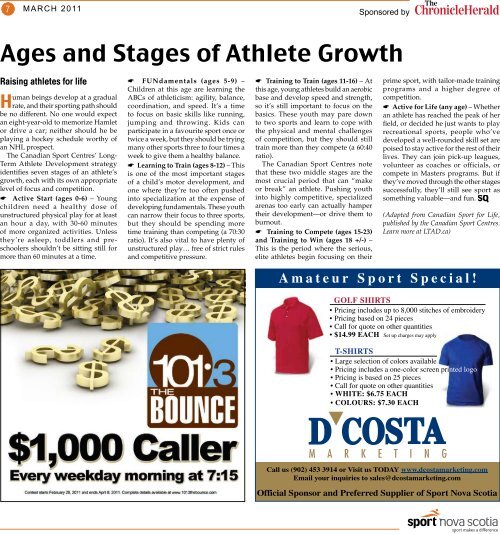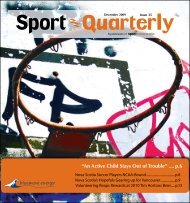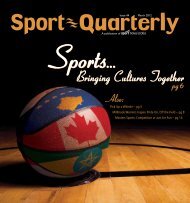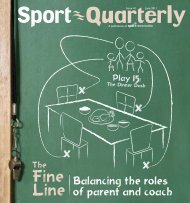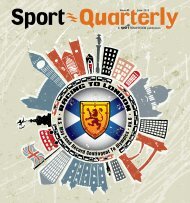VERSATILITY - Sport Nova Scotia
VERSATILITY - Sport Nova Scotia
VERSATILITY - Sport Nova Scotia
Create successful ePaper yourself
Turn your PDF publications into a flip-book with our unique Google optimized e-Paper software.
7<br />
Sponsored by<br />
Ages and Stages of Athlete Growth<br />
Raising athletes for life<br />
Human beings develop at a gradual<br />
rate, and their sporting path should<br />
e no different. No one would expect<br />
n eight-year-old to memorize Hamlet<br />
r drive a car; neither should he be<br />
laying a hockey schedule worthy of<br />
n NHL prospect.<br />
The Canadian <strong>Sport</strong> Centres’ Longerm<br />
Athlete Development strategy<br />
dentifies seven stages of an athlete’s<br />
rowth, each with its own appropriate<br />
evel of focus and competition.<br />
Active Start (ages 0-6) – Young<br />
hildren need a healthy dose of<br />
nstructured physical play for at least<br />
n hour a day, with 30-60 minutes<br />
f more organized activities. Unless<br />
hey’re asleep, toddlers and prechoolers<br />
shouldn’t be sitting still for<br />
ore than 60 minutes at a time.<br />
☛ FUNdamentals (ages 5-9) –<br />
Children at this age are learning the<br />
ABCs of athleticism: agility, balance,<br />
coordination, and speed. It’s a time<br />
to focus on basic skills like running,<br />
jumping and throwing. Kids can<br />
participate in a favourite sport once or<br />
twice a week, but they should be trying<br />
many other sports three to four times a<br />
week to give them a healthy balance.<br />
☛ Learning to Train (ages 8-12) – This<br />
is one of the most important stages<br />
of a child’s motor development, and<br />
one where they’re too often pushed<br />
into specialization at the expense of<br />
developing fundamentals. These youth<br />
can narrow their focus to three sports,<br />
but they should be spending more<br />
time training than competing (a 70:30<br />
ratio). It’s also vital to have plenty of<br />
unstructured play… free of strict rules<br />
and competitive pressure.<br />
☛ Training to Train (ages 11-16) – At<br />
this age, young athletes build an aerobic<br />
base and develop speed and strength,<br />
so it’s still important to focus on the<br />
basics. These youth may pare down<br />
to two sports and learn to cope with<br />
the physical and mental challenges<br />
of competition, but they should still<br />
train more than they compete (a 60:40<br />
ratio).<br />
The Canadian <strong>Sport</strong> Centres note<br />
that these two middle stages are the<br />
most crucial period that can “make<br />
or break” an athlete. Pushing youth<br />
into highly competitive, specialized<br />
arenas too early can actually hamper<br />
their development—or drive them to<br />
burnout.<br />
☛ Training to Compete (ages 15-23)<br />
and Training to Win (ages 18 +/-) –<br />
This is the period where the serious,<br />
elite athletes begin focusing on their<br />
prime sport, with tailor-made training<br />
programs and a higher degree of<br />
competition.<br />
☛ Active for Life (any age) – Whether<br />
an athlete has reached the peak of her<br />
field, or decided he just wants to play<br />
recreational sports, people who’ve<br />
developed a well-rounded skill set are<br />
poised to stay active for the rest of their<br />
lives. They can join pick-up leagues,<br />
volunteer as coaches or officials, or<br />
compete in Masters programs. But if<br />
they’ve moved through the other stages<br />
successfully, they’ll still see sport as<br />
something valuable—and fun.<br />
(Adapted from Canadian <strong>Sport</strong> for Life,<br />
published by the Canadian <strong>Sport</strong> Centres.<br />
Learn more at LTAD.ca)


